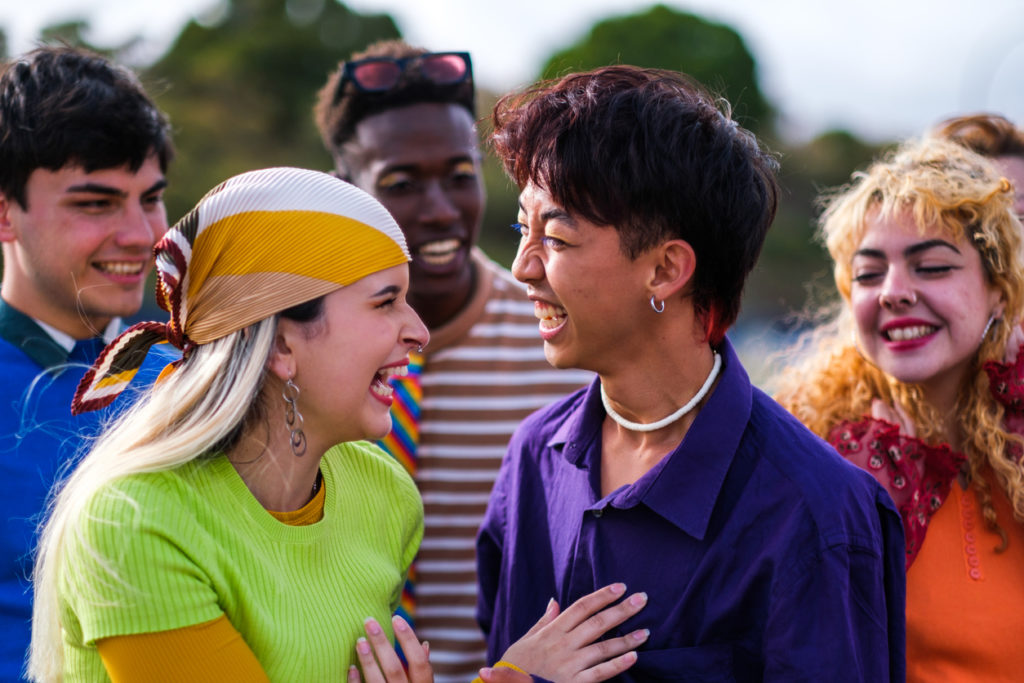Language is always changing and adapting, and LGBTQ+ terminology is no exception.
The most important thing you need to know about LGBTQ+ language and terminology is that you don’t need to know it all!
Most people want to use LGBTQ+ inclusive language, but are unsure where to begin. Terms change over time, and, even within the LGBTQ+ community, certain words that some people use to describe themselves are rejected by others.
If you would like to know more about LGBTQ+ inclusive language, a good place to start is to learn some of the key concepts and understand what the letters in LGBTQ+ stand for.
Our glossary defines LGBTQ+ and other LGBTQ+ terminology. A full version of our LGBTQ+ glossary is available for download here. You can view and print our LGBTQ+ terminology poster here.
LGBTQ+
This stands for lesbian, gay, bisexual, trans and queer. The plus sign includes people with other minority sexual orientations and gender identities.
Coming out
For LGBTQ+ people, coming out is the process of sharing your sexual orientation and/or your gender identity with people in your life. We usually think that an LGBTQ+ person comes out at one point in their life. In fact, most LGBTQ+ people come out more than once at different points in their lives – for example to different family members, when starting a new job, and when meeting new friends.
Outing
Sharing another person’s sexual orientation or gender identity without their permission, either deliberately or accidentally. Outing is disrespectful and presents danger for many LGBTQ+ people.
Sexual orientation
Our sexual and romantic attraction to other people.
Lesbian
A woman who is attracted to other women. Some non-binary people may also identify with this term.
Gay
Someone who is attracted to people of the same gender.
Bisexual or Bi
Someone who is attracted to more than one gender, for example both men and women.
Pansexual
Someone whose romantic and/or sexual attraction towards others is not limited by sex assignment, gender identity, or gender expression.
Asexual or Ace
Someone who experiences limited or no sexual attraction.
Straight or Heterosexual
Someone who is attracted to people of the opposite gender.
Gender identity
Our personal sense of our own gender.
Transgender or Trans
A term describing a person’s gender identity that does not match their assigned sex at birth. This word is also used as an umbrella term to describe some groups of people who transcend conventional expectations of gender identity or expression.
Sex assigned at birth
The designation of a person at birth as male or female based on their anatomy (genitalia and/or reproductive organs) or biology (chromosomes and/or hormones).
Non-binary
People whose gender identity is neither exclusively woman or man or is in between or beyond the gender binary.
Pronouns
The words used to refer to a person other than their name, e.g. he/she/they.
Cisgender or Cis
Someone whose gender identity matches the sex they were assigned at birth.
Gender expression
How we show our gender through our clothes, hair etc. This is different to gender identity. Gender identity refers to how we feel inside, and gender expression is how we present ourselves outside.
Queer
An umbrella term used to describe people who are not heterosexual and/or cisgender. Queer was used as a slur against the LGBTQ+ community for many years and still can be. However, the word has been reclaimed by LGBTQ+ communities and many now embrace the term. Check if someone is comfortable with this term before referring to them as queer.
Questioning
The process of exploring your sexual orientation, gender identity, and/or gender expression.
Intersex
This is an umbrella term used to describe a wide range of natural bodily variations that do not fit typical binary notions of male and female bodies, for example, variations in genetic, hormonal, or physical sex characteristics.
Ally
Someone who fights for, and supports others in their fight for, equality, despite not being a member of the marginalised group. For example, a straight and/or cisgender person who believes in, and fights for, LGBTQ+ equality.
Advice For Family Members
Learn about the difference between sexual orientation and gender identity, and how to support someone who comes out.
Learn MoreSupport for Family Members
There are a range of support services available for the loved ones of LGBTQ+ young people across the country.
Find Out More